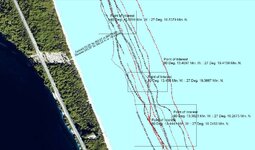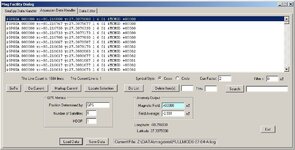I realize it is primitive by todays standards, but I was wondering if anyone has any experience with these units? What sort of detection range could I expect on a cannon/ large anchor in 3 to 5 fathoms?...how tight would I need to space my lanes in order to have a fair chance of success ?
You are using an out of date browser. It may not display this or other websites correctly.
You should upgrade or use an alternative browser.
You should upgrade or use an alternative browser.
Aquascan MC 4 magnetometer...
- Thread starter Jolly Mon
- Start date
SADS 669
Bronze Member
- Jan 20, 2013
- 2,454
- 3,734
- Detector(s) used
- Tesoro Sand Shark....Aqua pulse 1B....Equinox ll
- Primary Interest:
- Shipwrecks
I would love to know too....
old man
Bronze Member
I sold mine to signumops about 12 years ago. It worked pretty good in shallow water.I realize it is primitive by todays standards, but I was wondering if anyone has any experience with these units? What sort of detection range could I expect on a cannon/ large anchor in 3 to 5 fathoms?...how tight would I need to space my lanes in order to have a fair chance of success ?
PM signumops. I'm sure he can give you his report on whether it's worth buying one.
signumops
Hero Member
- Feb 28, 2007
- 756
- 226
- Detector(s) used
- Garrett, Minelab, Aqua-Pulse
- Primary Interest:
- All Treasure Hunting
The MC5 is/was a dependable magnetometer, predictable in behavior, but subject to limitations of all magnetometers of its type. I still have mine and it still works. I have only worked with two mags... the MC5 and the SeaSpy, the latter being a device that can be towed in any direction without earth magnetic field effects. The MC5 is, on the other hand, subject to variation in its sensitivity depending upon the direction of your tow. The SeaSpy can be towed in circles, for example, while the MC5 can not give you reliable results running in circles. Generally, you need to tow it parallel with the equator, but in my area, that was usually not possible and more often than not, I towed parallel to shore on a north-northwest to south-southeast survey line.
Certainly, one of the better qualities of the MC5 is its ability to adjust to ambient magnetic mass. Once it dwells, in a matter of a few seconds, it was sensitive enough to locate a steel core truck tire from a distance of 40 feet, for example. I can set it up in my front yard and it can sense vehicles approaching from a hundred yards. Vehicles on a southerly track will register a positive signal, while vehicles on a northerly track will register a negative signal. This behavior simulates towing the device, so you could expect to find a vehicle a hundred yards away under ideal conditions, provided no other mass of metal produced any competing signal.
Like its newer cousins, the MC5 produces a dipole signal when you cross directly over a target. Otherwise, the signal strength will vary to positive or negative depending upon which side of the target you pass, and in what direction you are towing at that moment. I towed my unit slung beneath a foam float so it was always at a fixed depth, but most of the time, working on 1715 Fleet wrecks, I was in shallow water, 30 feet or less. Working under those conditions, it is almost impossible to maintain any dignified pattern, or lane control so I devised my own mapping program to post-process the ASCII data produced by the unit. My control box was souped up by Bill Seliger Sr. and it supports an RS-232 port for collection of the mag's data. I have a 32 bit VB program I wrote to record and plot the data in real time, but, that's not really necessary: you can still simply tow the mag and throw bouys. The mag has a sound alarm and a meter/needle readout along with the ASCII data stream. I attached a shot of the data, and a chart of the Unknown Wreck area in detail showing MC5 data plotted with symbols indicating positive (red) and negative (black) symbols.
If you use an MC5, it is absolutely necessary that you totally isolate the power to 24 volts as batteries that are NOT attached to any generated circuit. Same goes for the computer you use to capture the ASCII data... the computer can not be hooked up to generated power... you have to rely solely upon the computer's battery to run it while collecting MC5 data.
Certainly, one of the better qualities of the MC5 is its ability to adjust to ambient magnetic mass. Once it dwells, in a matter of a few seconds, it was sensitive enough to locate a steel core truck tire from a distance of 40 feet, for example. I can set it up in my front yard and it can sense vehicles approaching from a hundred yards. Vehicles on a southerly track will register a positive signal, while vehicles on a northerly track will register a negative signal. This behavior simulates towing the device, so you could expect to find a vehicle a hundred yards away under ideal conditions, provided no other mass of metal produced any competing signal.
Like its newer cousins, the MC5 produces a dipole signal when you cross directly over a target. Otherwise, the signal strength will vary to positive or negative depending upon which side of the target you pass, and in what direction you are towing at that moment. I towed my unit slung beneath a foam float so it was always at a fixed depth, but most of the time, working on 1715 Fleet wrecks, I was in shallow water, 30 feet or less. Working under those conditions, it is almost impossible to maintain any dignified pattern, or lane control so I devised my own mapping program to post-process the ASCII data produced by the unit. My control box was souped up by Bill Seliger Sr. and it supports an RS-232 port for collection of the mag's data. I have a 32 bit VB program I wrote to record and plot the data in real time, but, that's not really necessary: you can still simply tow the mag and throw bouys. The mag has a sound alarm and a meter/needle readout along with the ASCII data stream. I attached a shot of the data, and a chart of the Unknown Wreck area in detail showing MC5 data plotted with symbols indicating positive (red) and negative (black) symbols.
If you use an MC5, it is absolutely necessary that you totally isolate the power to 24 volts as batteries that are NOT attached to any generated circuit. Same goes for the computer you use to capture the ASCII data... the computer can not be hooked up to generated power... you have to rely solely upon the computer's battery to run it while collecting MC5 data.
Attachments
Top Member Reactions
-
 2351
2351 -
 1135
1135 -
 1046
1046 -
 886
886 -
 828
828 -
 802
802 -
 756
756 -
 752
752 -
 606
606 -
 496
496 -
 495
495 -
 471
471 -
 466
466 -
 423
423 -
 388
388 -
 380
380 -
 376
376 -
 375
375 -
 372
372 -
O
371
Users who are viewing this thread
Total: 2 (members: 0, guests: 2)






